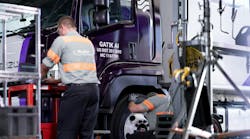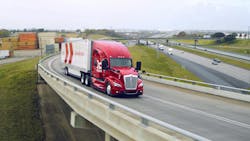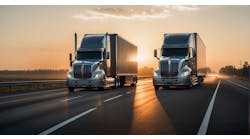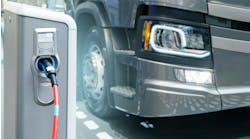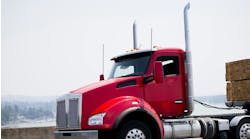This is Part Two of a two-part story. Click here to see Part One.
Autononmous vehicles (AVs) have been in development and testing for several years now, with some companies succeeding at introducing this technology more than others. In the meantime, drivers, fleet operators, and legislators have also been considering how these vehicles will impact the commercial trucking landscape, with some regulating AV technology and others avoiding the topic overall.
But as of the end of 2023, several AV developers are beginning to move towards scaled development, gradually introducing these vehicles to America's roadways. While this doesn't mean that the roads will be flooded with self-driving trucks tomorrow, it fleets should be aware of next steps for this technology and how it will impact their businesses.
Integrating AVs, step by step
This combination of working toward scaled development and an uncertain regulatory landscape means that many of the remaining AV developers are now looking to show how their technology fits into the overall trucking industry.
Richard Steiner, VP of government relations and public affairs at Gatik AI, explained that the company has seen a shift in regional distribution architecture, which has brought more, smaller warehouses in urban and semi-urban areas. This has begun to change the environment Gatik operates in and the repeatable routes it uses.
Over their five years of AV testing, Kodiak Robotics learned about building an AV system that will work for fleet partners, explained Daniel Goff, Kodiak director of external affairs.
“In the long run, operationally, you need things like a maintenance network, you need people who are able to rescue a truck if something happens, and you need operation center oversight, which we’ve built out and have in our Dallas office,” Goff noted.
They also learned through experience about the many details it takes to make a driverless vehicle resistant to wear and tear on the road, a critical element without drivers to handle small issues and maintenance. This included building computer enclosures on AVs to keep them secure or bolting down cables so they don’t come out.
Meanwhile, making sure AVs are easily adaptable for maintenance divisions is critical, too. Kodiak made sure its sensor pods, which take the place of mirrors on the side of the truck and contain all the sensor hardware, were approachable for fleet maintenance divisions.
“Those are basically plug-and-play; you can replace them in about 10 minutes without any specialized training,” Goff stated. Maintenance teams won’t need to fix the sensor pods whenever there’s an issue, either, as he explained that fleets will simply need to send their pods to the company for repair or replacement. “[Our fleet partners] look at that and they say, ‘Okay, our maintenance teams are able to do that,’” Goff concluded.
Nick Elder, VP of commercialization at Torc Robotics, stressed the importance of making sure AVs are accessible to technicians who keep up with today’s technology.
“While there may be new training requirements, technicians familiar with today’s electronic diagnostic systems should find the shift to servicing autonomous-enabled trucks fairly straightforward,” Elder said.
Beyond servicing AVs, Gatik’s Steiner emphasized how maintenance teams must go deeper on their post-service and pre-trip inspections.
“We have teams working on the pre-trip inspection aspect of things, [too],” Steiner noted. “We’re doing this before every single trip with every single aspect of our technology.”
Read more: Tyson Foods and Gatik deploy autonomous trucks in Arkansas
This includes verifying that every technological integration, from lidar, radars, and cameras to global positioning systems, are all in working order.
Looking ahead for AVs
What do the next few years of AVs look like now? For many of the remaining tech developers, the goal is to expand the routes that their vehicles can handle, all while continuing to build their safety cases and adapt to the unusual road events a human driver might understand, but a computer will not.
For Gatik, this means scaling up from 65 trucks commercially deployed in North America to 300 by the end of 2025. This starts with growing their Class 6 autonomous box truck operations in Dallas.
For Kodiak, the first order of business is to continue collecting data.
“We need to finish building what we call [AVs’] safety case, which is basically the proof that this system is safer than a human,” Kodiak’s Goff explained. “It’s really a steady accumulation of data that shows we can handle [a] very wide range of scenarios, we understand what is and is not likely to happen on the road, and we’re prepared for it.”
This means covering more miles with driverless trucks and comparing how the Kodiak Driver program behaves compared to a typical driver with the same number of miles under their belt. This also entails recording as many unusual or surprising road events as possible, tagging and evaluating them, and making sure that the software knows how to respond to such scenarios, all without accidentally ‘unlearning’ something the team previously programmed into the software.
All of these processes take time. And they’re partially why Stefan Heck, founder and CEO of Nauto, an AI and data platform for driver coaching, safety, and AV development, is certain that scaling AVs at the fleet level will still be a gradual process and roll out slowly across highways and regions.
“The bus systems will expand a little bit; the trucks will add Interstate 15 [to their AV capabilities],” Heck hypothesized. “And then eventually, somebody will figure out how to do Interstate 80, which is much more complicated because you’re going through Chicago and you’re going through snow.”
How AVs address the formidable challenges of blizzards and gridlock is uncertain at this moment, but it does appear developers are coming closer to figuring out the basics of autonomous trucking operations. It’s a long road ahead, but it’s a start.
